The Forbidden City
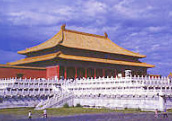
It is the largest and most well preserved imperial residence in China today. Under Ming Emperor Yongle, construction began in 1406. It took 14 years to build the Forbidden City. The first ruler who actually lived here was Ming Emperor Zhudi. For five centuries thereafter, it continued to be the residence of 23 successive emperors until 1911 when Qing Emperor Puyi was forced to abdicate the throne. In 1987, the United Nations Educational, Scientific and Cultural Organization recognized the Forbidden City as a world cultural legacy.It is believed that the Palace Museum, or Zi Jin Cheng (Purple Forbidden City), got its name from astronomy and folklore. The ancient astronomers divided the constellations into groups and centered them around the Ziwei Yuan (North Star). The constellation containing the North Star was called the Constellation of Heavenly God and the star itself was called the purple palace. Because the emperor was supposedly the son of the heavenly gods, his central and dominant position would be further highlighted by the use of the word purple in the name of his residence.
The Great Wall
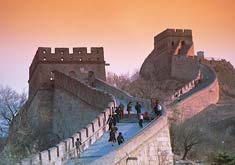
The Great Wall, symbolizing China's ancient civilization, is one of the world's most renowned projects. It is a distance of 75 kilometres northwest of Beijing. Its highest point at Badaling is some 800 metres above sea level.
Construction of the Wall first began during the period of the Warring States (476 - 221 BC). Formerly, walls were built at strategic points by different kingdoms to protect their northern territories. In 221 BC after the first Emperor of the Qin Dynasty unified China, he decided to have the walls linked up and extended.
Historical records show that about 1 million people, one-fifth of China's population at the time, were involved in the project which took more than ten years. When it was finished we call it "Wan Li Chang Cheng" which means "Ten Thousand-Li-Long Wall". Now, nature has taken over most of the Great Wall.The Great Wall which we are going to visit was rebuilt during the Ming Dynasty in the 16th century. It extends from Shanhaiguan Pass, a seaport along the coast of Bohai Bay, to Jiayuguan Pass in Gansu Province. Its total length is more than 6,700 kilometres.
There were many places of strategic importance along the Wall. Fortresses were constructed at strategic points. Beacon towers were built on both sides of the Wall at commanding points. Whenever the enemy was sighted, bonfires were lit on the towers to signal warning messages.
Before the Ming Dynasty, the Wall was built mainly of earth and rock. Under the Ming, it was rebuilt in most places with bricks and stones. For instance, the section at Badaling near Beijing was faced with slabsof rock and large bricks and filled with earth and stones. It is 6 to 7 metres high.
At regular intervals along the southern side of the Wall, there are gates with stone steps leading to the top of the Wall. The top surface of the wall is paved with three or four layers of large bricks. It is 4 to 5 metres wide, enough for five horsemen to ride abreast. Along the Wall, there are parapets and battlements built of bricks and turrets and watchtowers at regular intervals.
The Wall traverses mountains and gullies. It was extremely difficult to build along steep slopes under harsh conditions. Some of the slabs of rock were as long as two metres and weighed as much as one ton. All the rocks, bricks and lime had to be carried up the mountains at the cost of backbreaking labour. The earth and bricks were passed up from hand to hand or carried in baskets by donkeys and goats. The large slabs were moved up slopes by means of rolling rods and hoisting bars. According to rough calculation, the amount of bricks and rock used to build the Wall would have been enough to build a wall five metres high and one metre thick around the world.
The Summer Palace
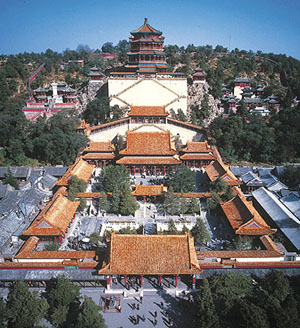
The summer Palace, located approximately twelve kilometers to the northwest of Beijing's city proper, was first built in 1750 and rebuilt in 1886. An outstanding example of imperial gardens in classical Chinese style, the Summer Palace spreads on an area of 2.9 million square metres, three fourths of which are water surfaces. Its major attractions are the Wanshou (longevity) Hill and the Kunming (Jade Spring)Lake. The garden is a showcase of pavilions in diversified, exotic designs which are strung together by a corridor more than seven hundred metres in length and a seemingly unending chain of balustrades of snow-white marble. With western hills simmering in the background, the Summer Palace is strewn with postcard perfect sceneries, including the Yuquan(Jade Spring)Pagoda, the Kunming Lake, and the bridge with seventeen arches. The huge garden's artistic style, which is at once kaleidoscopic and harmonious, is attributable to the unknown designers' ingenious landscaping skills.
The Temple of Heaven

Situated in Chongwen District, Tiantan, or Temple of Heaven, is a 2.7 million square metre affair which was first constructed in 1420 as the venue for emperors of the Ming and Qing dynasties to pray to Heaven for good harvests. The worldwide fame of Tiantan is attributed to its well disciplined layout and unique, elegantly ornamented architecture structures. The Qiniandian, or Hall of Prayer for Good Harvest, is the centerpiece of Tiantan, built in a unique Chinese style, it is a circular wooden structure 38 metres in height and 32 metres in diameter, with a triple conical roof topped with a huge gold-plated cupola.
The Tian'anmen Square
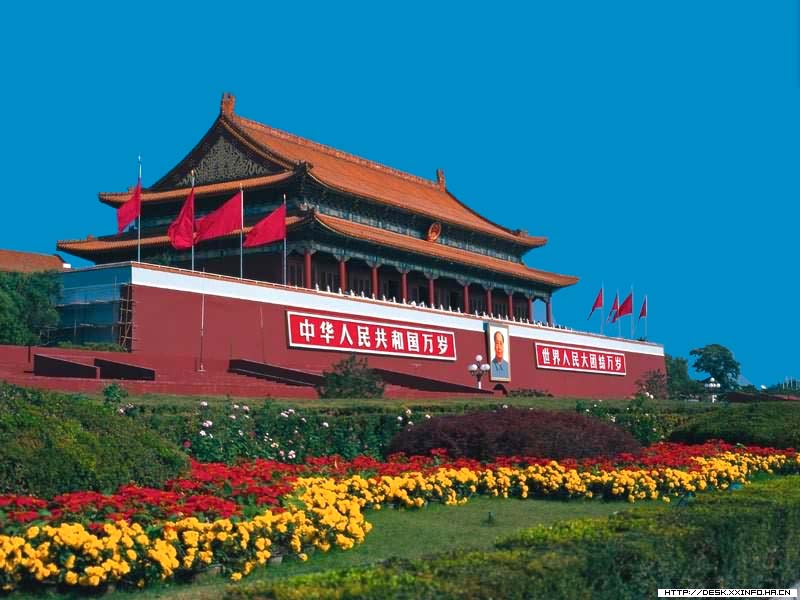
Tian'anmen square, or Gate of Heavenly Peace, sits at the entrance to the former Forbidden City, the imperial residential quarter of the Ming and Qing dynasties, and towers over the immense square of the same name. The gate, first built in 14167 as the front gateway to the imperial capital, consists of a double-roofed tower with nine frontal columns, elevated upon a red platform with five vaulted gateways. From base to rooftop the structure stands 33.7 metres in height. The vermillion platform beneath the tower rises more than ten metres high upon a white marble pedestal. The tower looks majestic with its double roofs and flying eaves, yellow glazed tiles and vermillion walls, elaborately carved brackets and beams and painted pillars. Tian'anmen is a symbol of New China. A rendition of it forms the centerpiece of the Chinese national emblem. The ceremony to inaugurate the People's Republic of China took place at Tian'anmen on October 1,1949.
The Ming Tombs
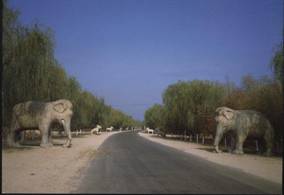
The Ming Dynasty lasted from 1368 to 1644. The first Ming emperor had his tomb built in Nanjing, the town which he had chosen for his capital. As his eldest son died early, he was succeeded by his grandson, who became the second emperor. His fourth son, the Prince of Yan, was guarding the northern frontier near Beijing with an army 100,000 strong. The second emperor attempted to weaken his forces but was met with counter-attacks. After a 3-year war he was ousted and lost track of completely. So, the fourth son became the third emperor, Emperor Yongle, of the Ming Dynasty.
As a frontier commander, he was aware that a peaceful northern frontier was of great importance to the Ming Palace, he chose this valley to build his tomb. All his successors followed his example and had their tombs built here, except one who was dethroned and buried in the western suburb. Out of the sixteen emperors, thirteen lie here with their empresses and concubines.
The site was chosen with the greatest care, with geomancy taken into account. The tombs are located about 50 kilometres to the north of Beijing. They are scattered over a basin approximately 40 square kilometres in area, screened by mountains on three sides and open to the Beijing Plain in the south. The road leading to the tombs is guarded by the Tiger Hill on the left and the Dragon Hill on the right. It was a forbidden ground except for those who were officially in charge of its upkeep. It was not allowed to cultivate land, cut wood or to take stones from here. No one could enter it on horseback, even the emperor himself had to dismount at the gate.